A Private Tour today in North Norfolk. It was a gloriously sunny day, great weather to be out and about. We met in Wells and headed west along the coast.
Our first stop was at Choseley. There have been several Dotterel here for a few days now and it didn’t take us long to get onto them. There were meant to be 18 of them today, but we could only see 14 – not a surprise, as they can disappear completely amongst the stones in the field if they stop and sit down. They were a bit distant, but through the scope we could see them well, running around out in the field. A great way to start the day, before the heat haze gets too bad here.
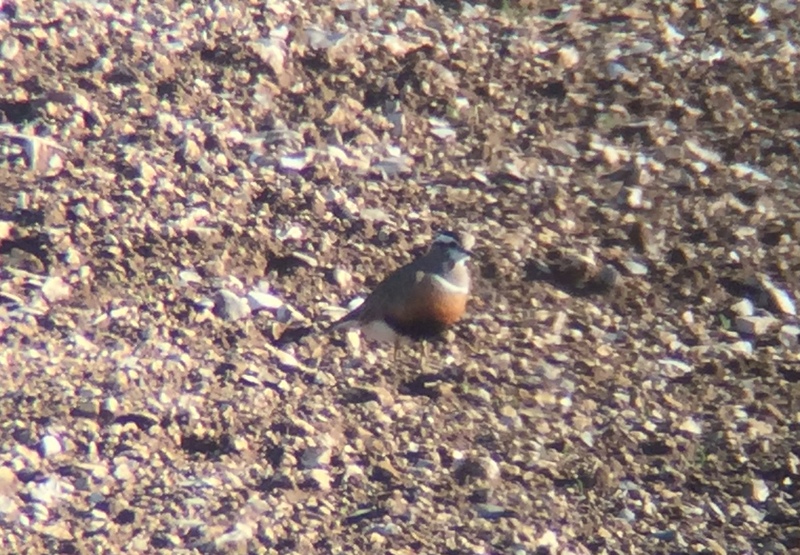 Dotterel – here’s one from yesterday
Dotterel – here’s one from yesterday
As we drove down to the Dotterel, there were lots of Yellowhammers in the hedges by the road, but no sign of any Corn Buntings this morning. On our way further west, we drove with the windows down and eventually heard the distinctive sound of jangling keys that is a Corn Bunting singing. We stopped the car and got out to look at it, a surprisingly big and chunky bunting, singing from the wires by the road.
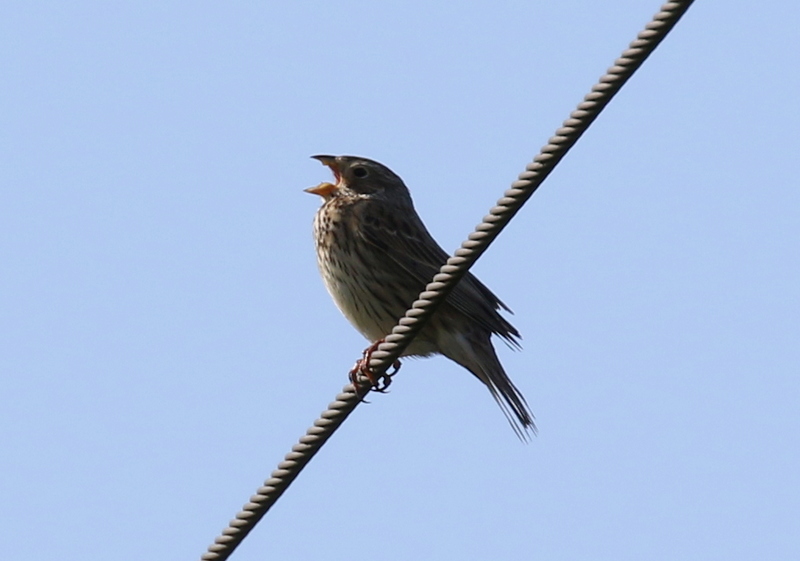 Corn Bunting – sounding like a bunch of jangling keys
Corn Bunting – sounding like a bunch of jangling keys
Our next stop proper was at Snettisham Coastal Park. There were lots of warblers singing as we walked out through the bushes. Common Whitethroat, Sedge Warbler and Blackcap first, then Willow Warbler and Chiffchaff. Several Lesser Whitethroats were flitting around, less vocal than some of their peers this morning. A Garden Warbler was a nice surprise, the first we have heard here this spring. Further along, in the wetter, reedier bits, we could hear Reed Warblers singing and a Cetti’s Warbler or two shouting at us.
We were almost at the north end when eventually we heard a Grasshopper Warbler, just audible in the distance above the noise of the vehicle cutting the banks along the inner seawall. We walked over and it seemed to come closer too, so that eventually we could hear it not far in front of us. It appeared in a low hawthorn, then flitted over to a larger bush. We could hear it still reeling on and off, and then found it perched deep among the branches. We had a great view of it through the scope, but it wouldn’t come out into full view today. That did though take us to a cool 10 warbler species for the day, and for the Coastal Park today.
 Grasshopper Warbler – reeling from deep in the bushes today
Grasshopper Warbler – reeling from deep in the bushes today
There were lots of other birds to see here. The Coastal Park is always chock full of Linnets and Goldfinches. Several small parties also seemed to be on the move, flying south overhead, though it is often difficult to tell migrants from local birds here. The Yellow Wagtails were definitely on the move, and we had a steady trickle over here this morning.
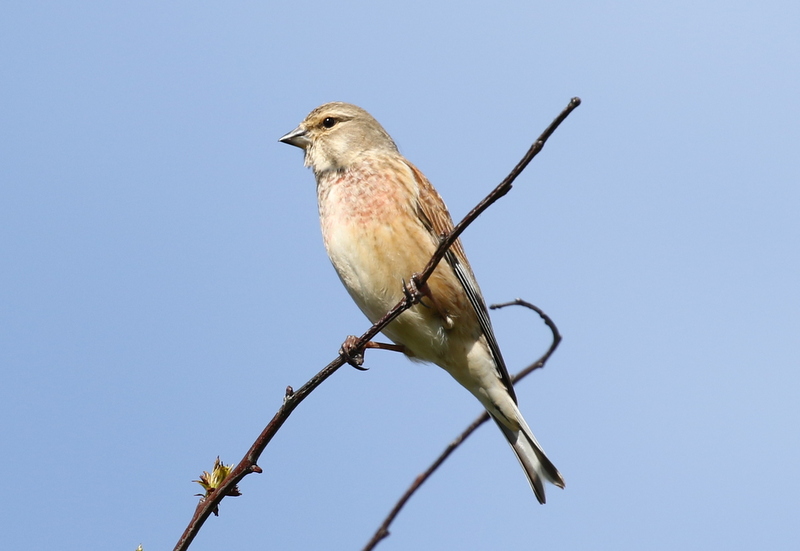 Linnet – a male with a red-pink flushed breast
Linnet – a male with a red-pink flushed breast
We had a quick look out at the Wash, but the tide was out. We could see vast flocks of waders out in the distance, mostly Knot, but also godwits and Grey Plover. Closer in, just below the bank, was a single Ringed Plover.
We cut across to the inner seawall at the north end. Several Whimbrel were feeding out in the grass the other side of the cross bank. The grazing marshes on the inland side of the seawall added a variety of commoner waterfowl.
Snettisham Coastal Park is normally a good site for Cuckoo, but we had neither seen nor heard one on our walk round today. We were almost back at the car when a Cuckoo appeared flying through the bushes. It did a wide circuit round us, before landing in the top of a hawthorn where we could see it well. Then it flew off and disappeared out of view, although we could still hear it ‘cuckoo-ing’ in the distance.
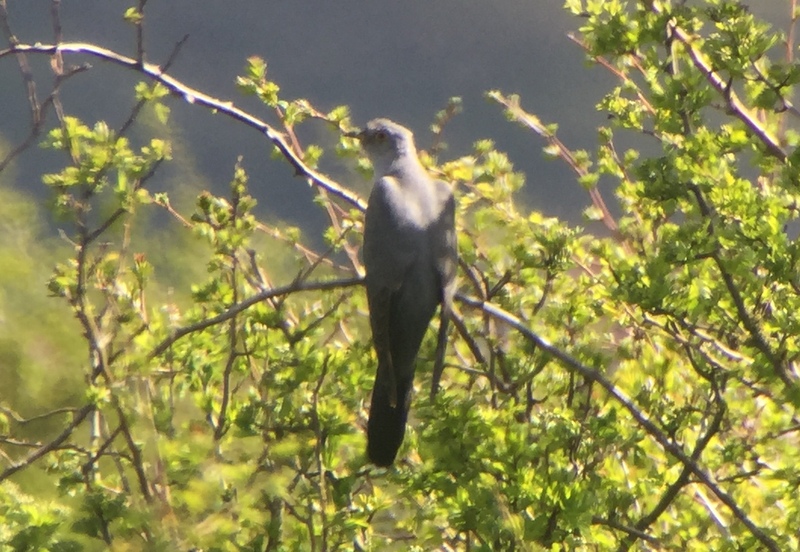 Cuckoo – finally appeared as we were almost back to the car
Cuckoo – finally appeared as we were almost back to the car
We made our way back along the coast road and a quick detour at Hunstanton added Fulmar to the day’s list without even stopping, with a couple of them hanging in the air over the clifftops as we passed. Holme was our next destination, and we parked up and had a quick walk round past the paddocks.
A Common Whitethroat sang from the bushes as we walked along, and a Goldcrest singing in the pines finally showed itself too. There were Blackcaps and Lesser Whitethroats too, and a small flock of tits passed through the area. A few Swifts and hirundines were moving through here as well, including several House Martins and Sand Martins. But there was no sign of any Turtle Doves – one had been seen a little earlier, but had gone to ground. It was the middle of the day, which is always a quieter time.
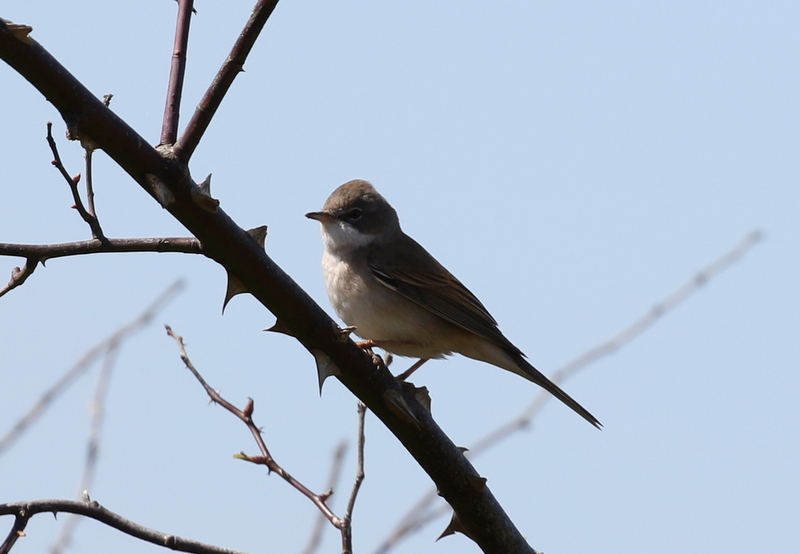 Common Whitethroat – singing by the path at Holme
Common Whitethroat – singing by the path at Holme
We drove down to the Firs for lunch, stopping on the way for a couple of Wheatears in the horse paddocks. After lunch, we continued our way back along the coast.
Our visit to Titchwell was brief, but successful. Several Reed Warblers were singing from the reeds, and we finally got a good look at one. These have only returned here in the last week or so. There were good numbers of Sedge Warbler and Cetti’s Warbler too.
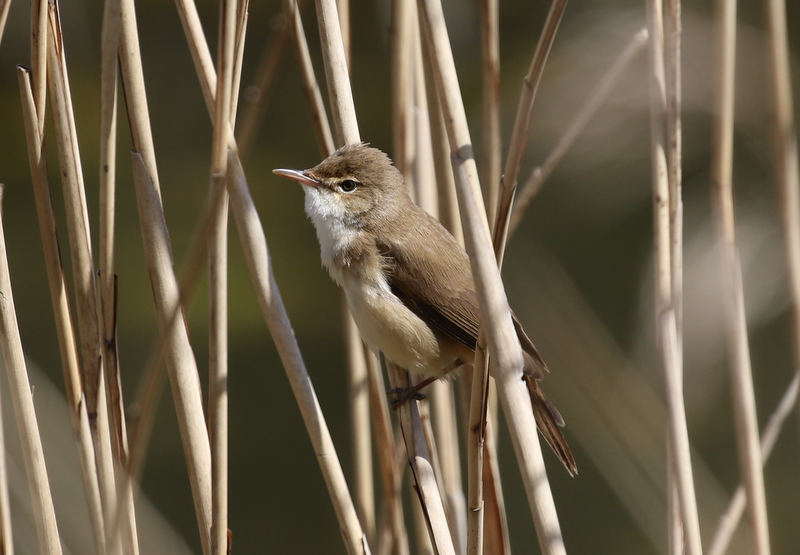 Reed Warbler – great views at Titchwell
Reed Warbler – great views at Titchwell
We stopped to look at the increasingly dry grazing meadow ‘pool’. At first it looked pretty dead, but we eventually found a single silvery-grey backed White Wagtail, and a black-backed Pied Wagtail for comparison.
There were a few ducks out on the reedbed pool, including a couple of smart drake Red-crested Pochard, looking mighty fine with their bright orange punk haircuts. A single female Goldeneye was a late surprise. A Marsh Harrier was hanging in the air over the reeds beyond. A Bearded Tit ‘pinged’ and flew across before ditching back into the reeds.
There had been a Little Gull around the reserve earlier, and suddenly it appeared in front of us. A superb, smart summer adult, we could see the small size, dainty flight, blackish underwings and pale white wing tips.
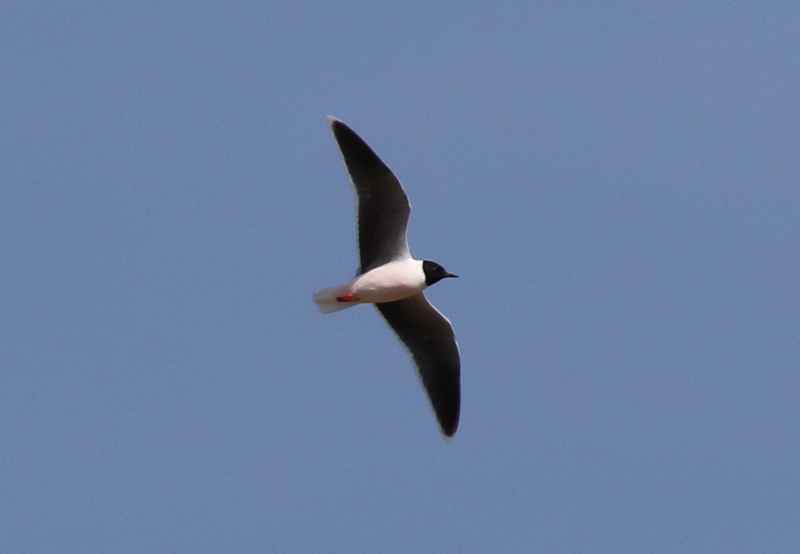 Little Gull – a cracking adult
Little Gull – a cracking adult
There is still quite a lot of water on the freshmarsh at the moment. On first glance, it can look rather empty, apart from the ubiquitous Avocets and there was a tight group of around 50 Black-tailed Godwit. A pair of Common Terns were resting on the nearest island.
We walked round to Parrinder Hide for a better look. On the way , we stopped to admire a couple of Little Ringed Plover on one of the islands, their golden yellow eyering shining in the sunlight. A pair of Shoveler were feeding just below the bank.
 Shoveler – feeding just below the main bank today
Shoveler – feeding just below the main bank today
From Parrinder Hide, it didn’t take us long to locate the main attraction. The Little Stint was feeding on the edge of the main ‘Avocet’ island, inside the new boundary fence. It was not a great view looking through the fence, but we could still see what it was.
 Little Stint – hard to see behind the new anti-predator fence
Little Stint – hard to see behind the new anti-predator fence
With our main target acquired, we moved on. The Volunteer Marsh was quiet again today, apart from a smart couple of Grey Plover along the tidal channel. A couple of Avocets were feeding right by the main path.
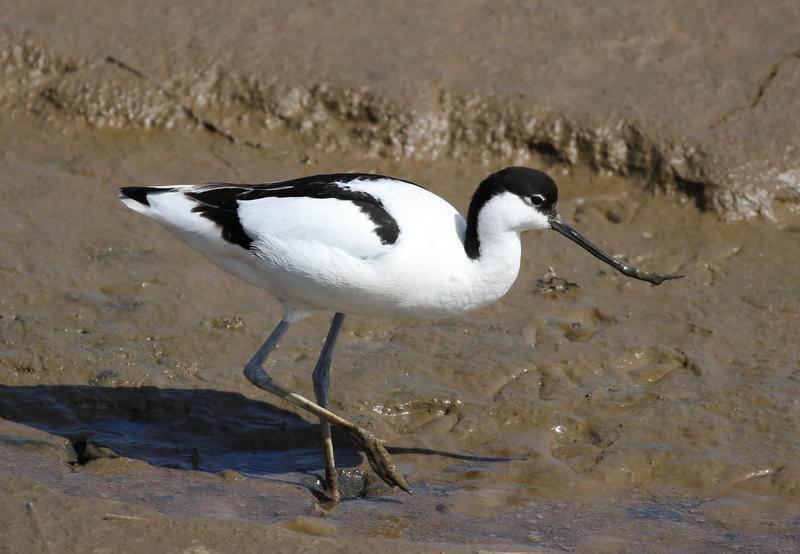 Avocet – no visit to Titchwell is complete without an Avocet photo
Avocet – no visit to Titchwell is complete without an Avocet photo
The Tidal Pools were also rather devoid of life, apart from a large flock of Turnstone which had moved in to one of the islands, including some very smart increasingly summer-plumaged birds. We made our way straight out to the beach. The tide was well in, but there were still a few waders out on the sand. Several of the Sanderling are now getting in to summer plumage, so are not quite so silvery-grey on the upperparts. Little groups were running in and out of the waves. Further over, there were a couple of flocks of Oystercatcher on the beach. Then four Bar-tailed Godwits flew in and landed in amongst them.

A couple of Sandwich Terns were fishing offshore, over towards Scolt Head and a Little Tern flew past, hovering up in the air before diving down into the water a couple of times. There appeared to be nothing else of note out to sea, so we made our way back. A smart Yellow Wagtail was in with the Pied and White Wagtails back on the grazing meadow pool now.
We still had time to stop in at Holkham next.A quick stop along the road produced a couple of Spoonbills flying round the trees. One headed over towards us, but dropped down into a reedy pool out of view. There were lots of geese out on the grazing meadows, mostly Greylags, but in with them we found a small group of lingering Pink-footed Geese. Most have now left for Iceland, but a handful of mostly sick or injured birds will normally stay right through the summer.
At least six Whimbrel were in one of the fields along Lady Anne’s Drive and a couple of Curlew were further over. The walk west alongside the pines added various species to the day’s list. A Coal Tit was feeding in the pines. We could hear a Treecreeper singing, and then it appeared suddenly as it flew out a small tree in front of us. A Jay called and we managed to see it flying across through the tops of the pines.
It was lovely and warm now and there were lots of butterflies out – many Peacocks, plus Orange Tip, Holly Blue and Comma. As we got out into the dunes, we could hear Natterjack Toads calling. Even better, as we walked along, one strolled across the path in front of us. We could see the yellow stripe down its back.

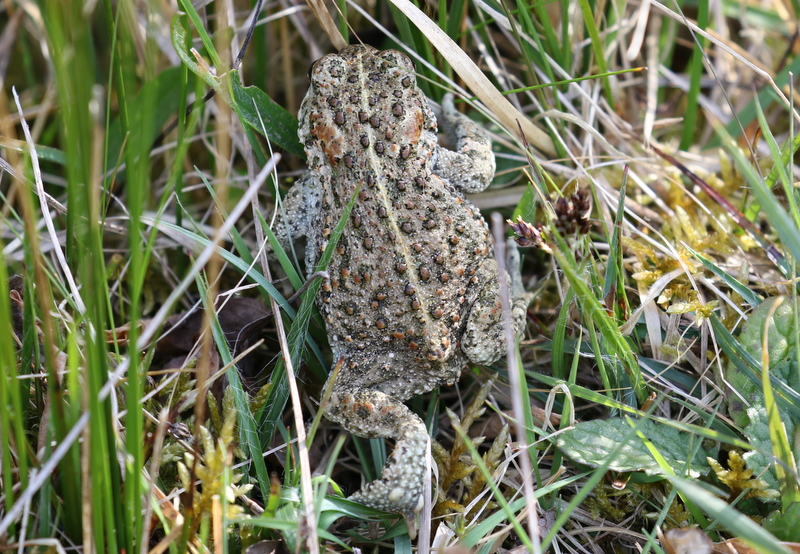 Natterjack Toad – with the distinctive yellow dorsal stripe
Natterjack Toad – with the distinctive yellow dorsal stripe
Unfortunately, we were running out of time and didn’t have a chance to explore the dunes more thoroughly today. A quick scoot round the dunes at the end of the pines added a few bits and pieces to the day’s list. There were several Wheatears in the dunes, but we couldn’t find much else in the way of migrants here. A male Stonechat perched up in the bushes. A Mistle Thrush was feeding on the short grass.

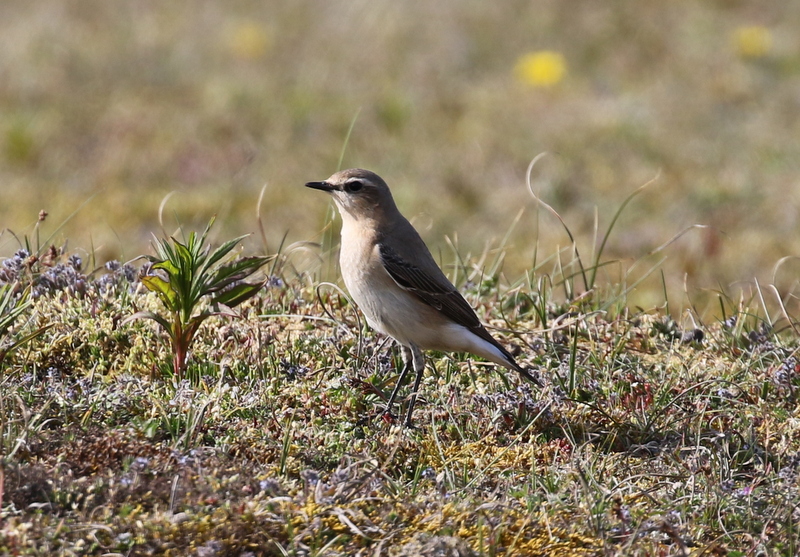 Wheatear – there were several in the dunes this afternoon
Wheatear – there were several in the dunes this afternoon
Then we had to make our way back. A Little Egret perched precariously in a bush by Salt’s Hole as we passed. As we drove back up Lady Anne’s Drive on the way back to Wells, a pair of Grey Partridge were in one of the fields.
It had been a whistlestop tour round several sites, but we had seemingly amassed quite a tally of birds for the day. It was only back at base that we got a chance to add it all up – 108 species and 1 subspecies (White Wagtail). Not bad at all for a day when we had not set out to see as many birds as possible. The joys of spring birding in Norfolk!
















